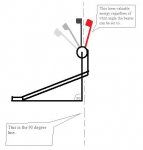wormtownpaul
Senior Member
I have both a DW 8000 and a Yamaha Flying Dragon, play on a Fibes maple set. With neither pedal is my beater perpendicular to the ground with it strikes the head. I have to go a little beyond perpendicular for the strike to occur.
1) How important is it that the strike take place at that perpendicular angle?
2) Are there any beaters out there that would address this issue. The only beater I've used that allows for such adjustments is from Axis, but it is so top heavy that I just don't like it.
1) How important is it that the strike take place at that perpendicular angle?
2) Are there any beaters out there that would address this issue. The only beater I've used that allows for such adjustments is from Axis, but it is so top heavy that I just don't like it.



